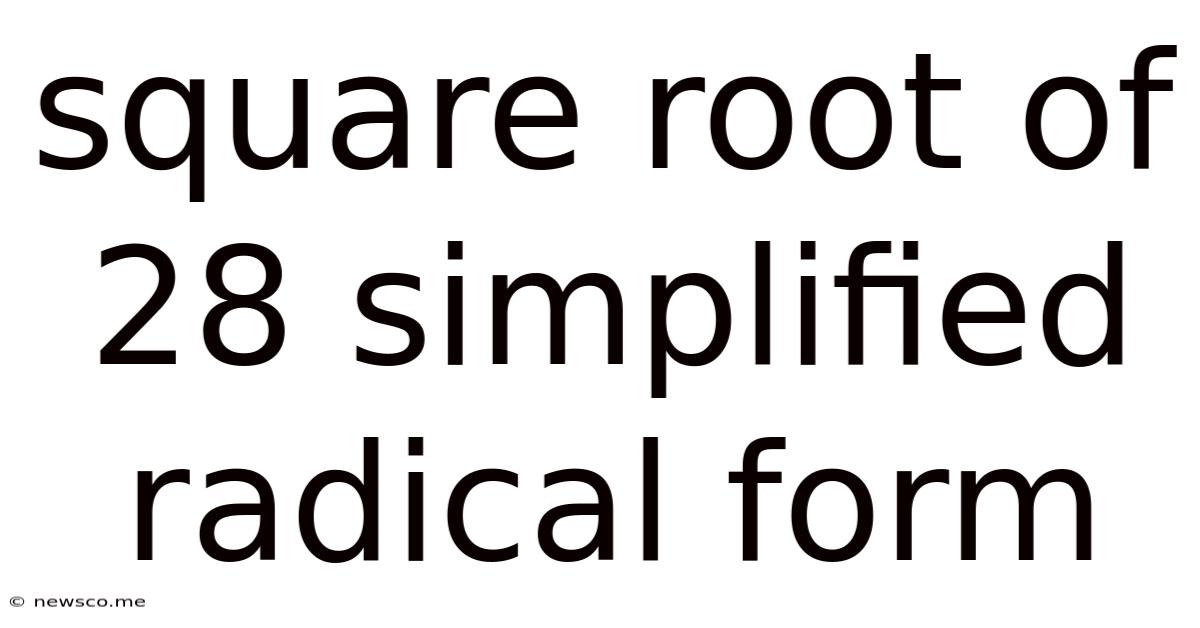Square Root Of 28 Simplified Radical Form
News Co
Mar 25, 2025 · 4 min read

Table of Contents
Simplifying the Square Root of 28: A Comprehensive Guide
The square root of 28, denoted as √28, isn't a perfect square. This means it can't be expressed as a whole number. However, we can simplify it to its simplest radical form, making it easier to work with in mathematical calculations and problem-solving. This guide provides a detailed explanation of how to simplify √28, exploring the underlying concepts and offering various approaches to reach the solution. We’ll also delve into related concepts to strengthen your understanding of radical simplification.
Understanding Square Roots and Radicals
Before we dive into simplifying √28, let's establish a solid foundation. A square root of a number is a value that, when multiplied by itself, gives the original number. For example, the square root of 9 (√9) is 3, because 3 x 3 = 9. A radical is an expression that includes a radical symbol (√), indicating a root (in this case, a square root). Numbers that are not perfect squares, like 28, have irrational square roots—meaning they cannot be expressed as a simple fraction.
Prime Factorization: The Key to Simplification
The most effective method for simplifying radicals like √28 involves prime factorization. Prime factorization is the process of breaking down a number into its prime factors—numbers that are only divisible by 1 and themselves. The prime numbers less than 28 are 2, 3, 5, 7, 11, 13, 17, 19, 23.
Let's find the prime factorization of 28:
- 28 can be divided by 2: 28 = 2 x 14
- 14 can also be divided by 2: 14 = 2 x 7
- 7 is a prime number.
Therefore, the prime factorization of 28 is 2 x 2 x 7, or 2² x 7.
Simplifying √28 Using Prime Factorization
Now that we know the prime factorization of 28 (2² x 7), we can simplify the square root:
√28 = √(2² x 7)
Because the square root of a product is the product of the square roots, we can rewrite this as:
√28 = √(2²) x √7
Since √(2²) = 2, our simplified expression becomes:
√28 = 2√7
Therefore, the simplest radical form of √28 is 2√7.
Alternative Methods for Simplifying Radicals
While prime factorization is generally the most efficient method, here are a couple of alternative approaches to simplify square roots:
Method 1: Identifying Perfect Square Factors
This method involves identifying perfect square factors within the number. A perfect square is a number that is the square of an integer (e.g., 4, 9, 16, 25).
Looking at 28, we can see that it's divisible by 4, which is a perfect square (2²). We can rewrite 28 as 4 x 7:
√28 = √(4 x 7) = √4 x √7 = 2√7
This method achieves the same result as prime factorization, but it relies on recognizing perfect square factors, which may not always be immediately obvious for larger numbers.
Method 2: Using a Factor Tree
A factor tree is a visual tool to help with prime factorization. You start with the original number (28) and branch out, showing its factors until you only have prime numbers remaining.
28
/ \
4 7
/ \
2 2
From the factor tree, you can see that 28 = 2 x 2 x 7 = 2² x 7. Then, you follow the same steps as the prime factorization method to simplify the radical.
Practicing Radical Simplification
Let's solidify your understanding with a few more examples:
-
√72: The prime factorization of 72 is 2³ x 3². Therefore, √72 = √(2³ x 3²) = √(2² x 2 x 3²) = 2 x 3√2 = 6√2
-
√125: The prime factorization of 125 is 5³. Therefore, √125 = √(5³) = √(5² x 5) = 5√5
-
√108: The prime factorization of 108 is 2² x 3³. Therefore, √108 = √(2² x 3² x 3) = 2 x 3√3 = 6√3
By consistently applying the prime factorization method or identifying perfect square factors, you can effectively simplify any radical expression.
Advanced Applications and Related Concepts
Simplifying radicals isn't just a mathematical exercise; it’s a crucial skill applied in various fields, including:
-
Algebra: Simplifying radicals is essential for solving equations and simplifying algebraic expressions, particularly those involving quadratic equations.
-
Geometry: Calculations involving areas, volumes, and distances often require simplifying radicals, especially when dealing with triangles and other geometric shapes.
-
Trigonometry: Trigonometric functions frequently involve irrational numbers, making radical simplification a necessary step in solving trigonometric equations and problems.
-
Calculus: Simplifying radicals is important for differentiating and integrating functions that include radical expressions.
Conclusion: Mastering Radical Simplification
Mastering the simplification of radicals, particularly expressions like √28, is fundamental to success in various mathematical disciplines. The prime factorization method provides a clear, systematic, and universally applicable approach to achieve the simplest radical form. By understanding the underlying principles and practicing regularly, you'll build confidence and proficiency in tackling more complex radical expressions and applying this knowledge to broader mathematical problems. Remember, practice makes perfect! Consistent practice with various examples will help you quickly and efficiently simplify radicals in any mathematical context.
Latest Posts
Latest Posts
-
Find The Point On The Y Axis Which Is Equidistant From
May 09, 2025
-
Is 3 4 Bigger Than 7 8
May 09, 2025
-
Which Of These Is Not A Prime Number
May 09, 2025
-
What Is 30 Percent Off Of 80 Dollars
May 09, 2025
-
Are Alternate Exterior Angles Always Congruent
May 09, 2025
Related Post
Thank you for visiting our website which covers about Square Root Of 28 Simplified Radical Form . We hope the information provided has been useful to you. Feel free to contact us if you have any questions or need further assistance. See you next time and don't miss to bookmark.